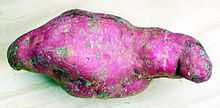Rongo
In "Mangaian society", the "ritual system" to become "the principal chief, Te Mangaia," "emphasized the worship of Rongo" (Kirch 29).[3] "The installation of a new Te Mangaia after a war of conquest of the puna lands required a human sacrifice to the god Rongo at his principal temple of Orongo. Rongo was both the god of war and the god of taro irrigation; his regular peacetime offerings were parcels of cooked taro" (Kirch 28).[3]
Origin
Rongo, with his brothers Tū, Tāne, Tane Mahuta, Tāwhirimātea, Tangaroa and Haumia-tiketike, separated the primordial parents Rangi and Papa to allow daylight into the world. Tāwhirimātea, the god of storms, did not consent to this plan and afterwards attacked his brothers with unrelenting fury. Rongo and Haumia, the god of wild food, took refuge in the body of Papa, mother earth, who hid them until the storm passed (Grey 1956:7, Tregear 1891:424,Orbell 1998:121).
Kūmara
In the Māori language, ‘rongo’ means peace. Rongo is generally portrayed as the creator of the kūmara, a plant associated with peace (probably because the intense cultivation it needed was best performed in times of peace). In Ngāti Awa traditions, Rongo is a son of Tāne and father of the kūmara, but a man named Rongo-māui travels to the star Whānui, obtains the kūmara and returns to Earth with it.[1]
Small statues representing Rongo were once placed alongside kumara fields.[2]
Other names and epithets
- Rongo-mā-tāne
 Kūmara (sweet potato)
Kūmara (sweet potato)
References
- ↑ "Origin of Theft", Royal Society of New Zealand, 1899
- ↑ "Kumaras and Kumara Magic", Te Ao Hou, 1962
3. "Natural Experiments of History", The Belknap Press of Harvard University Press, 2010
Bibliography
- G. Grey, Polynesian Mythology, Illustrated edition, reprinted 1976. (Whitcombe and Tombs: Christchurch), 1956.
- M. Orbell, The Concise Encyclopedia of Māori Myth and Legend (Canterbury University Press: Christchurch), 1998.
- E.R. Tregear, Maori-Polynesian Comparative Dictionary (Lyon and Blair: Lambton Quay), 1891.
- Patrick V. Kirch, "Natural Experiments of History" anthology edited by Jared Diamond and James A. Robinson, Chapter one "Controlled Comparison and Polynesian Cultural Evolution" by Patrick V. Kirch, pages 28 & 29, (The Belknap Press of Harvard University Press Cambridge, Massachusetts & London, England), 2010.
